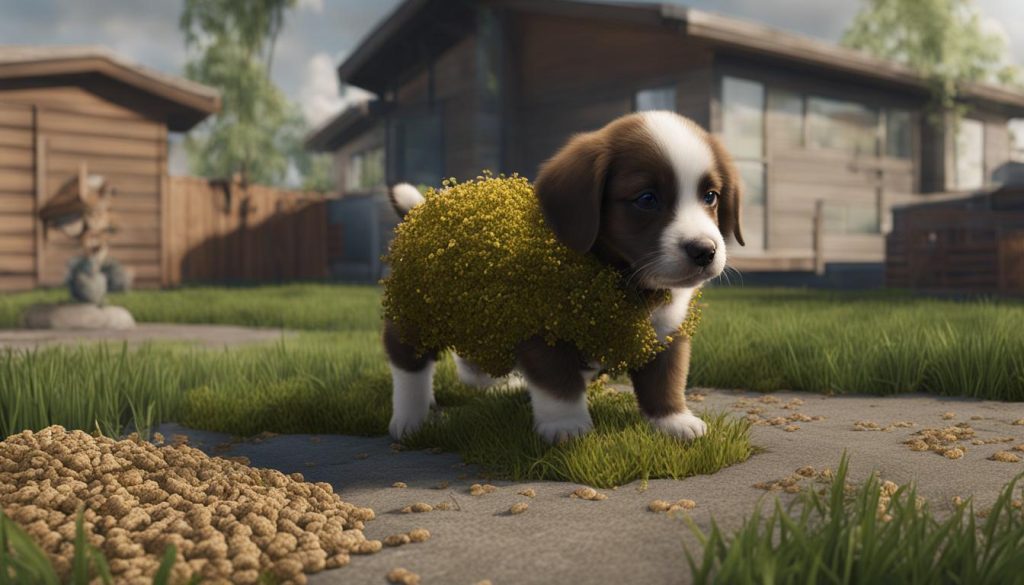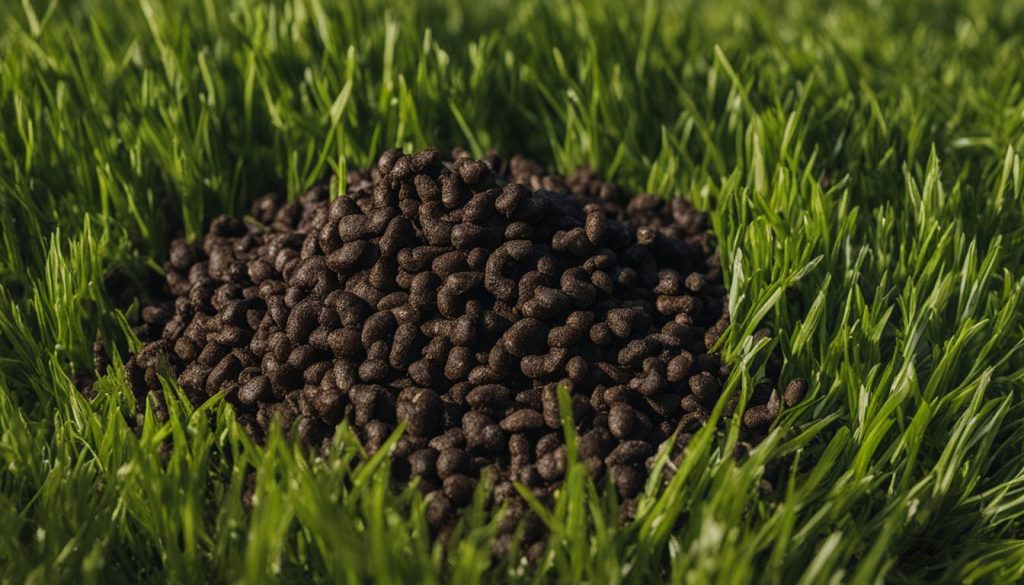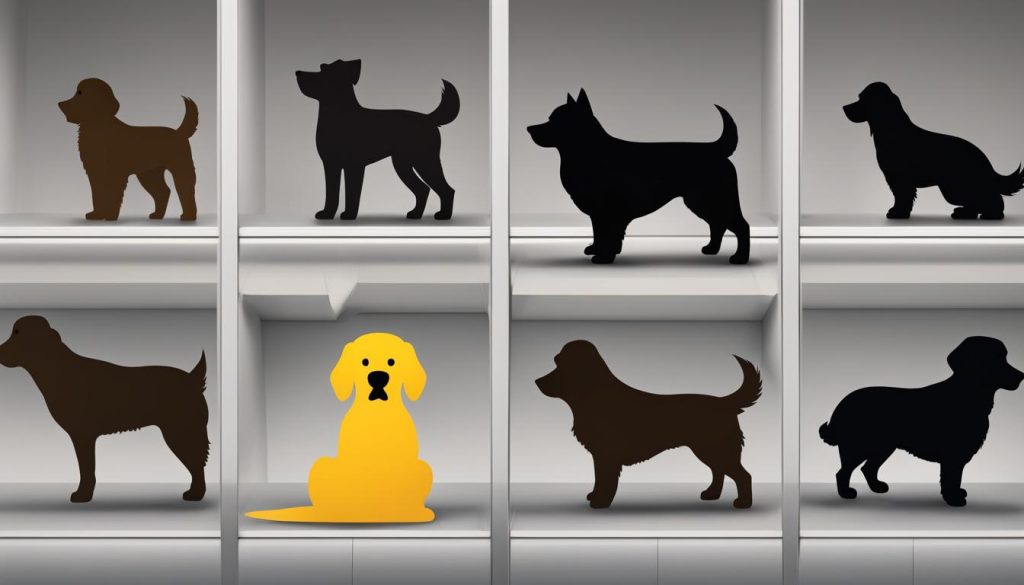In this article, I will provide a comprehensive guide on how often a puppy should poop and what factors can influence their bowel movements. As a pet owner, it’s essential to understand your puppy’s pooping frequency to ensure their overall health and well-being.
Puppies, due to their small size and developing digestive system, tend to poop more frequently than adult dogs. It’s not uncommon for a puppy to defecate 5-6 times a day. However, as they grow older, this frequency will gradually decrease.
By the age of 12 weeks, puppies may poop about 4 times a day, and by 6 months, it may be down to 3 times a day. Once a puppy reaches adulthood, they generally poop once a day, although it can vary up to 3 times.
It’s crucial to note any sudden changes in your puppy’s pooping routine and discuss them with a veterinarian. Monitoring their pooping habits can help identify potential health issues early on.
Key Takeaways:
- A puppy’s poop frequency is higher than that of an adult dog due to their small size and developing digestive system.
- As puppies grow older, their poop frequency gradually decreases.
- By 12 weeks, puppies may poop about 4 times a day, and by 6 months, it may be down to 3 times a day.
- A fully grown adult dog usually poops once a day, but it can vary up to 3 times.
- Any sudden changes in your puppy’s pooping routine should be monitored and discussed with a veterinarian.
Why Do Puppies Poop More Frequently?

Puppies have a higher frequency of pooping compared to adult dogs due to several factors. Their faster metabolism and larger food intake result in more frequent bowel movements. Additionally, their developing digestive system is not as efficient as that of adult dogs, leading to less thorough digestion and increased poop output. As puppies grow older, their digestive system matures, and the frequency of pooping gradually decreases.
Maintaining a healthy poop routine is crucial for puppies to ensure their overall well-being. By monitoring their poop schedule and patterns, you can identify any abnormality or health issues early on. Establishing consistency in their poop routine can also help you track their digestive health and quickly detect any changes or concerns.
Factors Influencing Puppy Poop Schedule
Several factors influence a puppy’s poop schedule. These include:
- Diet: A puppy’s food type, quality, and portion size can impact their digestion and poop frequency.
- Age: Younger puppies have faster metabolisms and less efficient digestive systems, resulting in more frequent pooping.
- Activity level: Puppies that are more active tend to have increased bowel movements.
- Stress and anxiety: Changes in a puppy’s environment or routine can affect their digestive system and poop schedule.
By understanding these factors and monitoring your puppy’s poop schedule, you can maintain a healthy routine and promptly address any concerns with your veterinarian.
What is Considered Normal for Puppies?
When it comes to tracking puppy pooping frequency, it’s important to understand what is considered normal. While the average puppy may poop around 5 times a day, there can be variations in the frequency depending on various factors such as age, diet, and overall health. However, it is crucial to pay attention to the consistency, color, and texture of their poop, as these can provide valuable insights into their digestive health.
A healthy puppy’s poop should resemble a soft, well-formed Tootsie roll. It should not be too hard or too loose. If you notice any significant changes in consistency, such as hard, dry stools or diarrhea-like poop, it may indicate an underlying issue that requires attention. Additionally, keep an eye out for any foreign objects present in the stool, as this could be a sign of a gastrointestinal blockage.
Monitoring your puppy’s poop consistency can help you identify potential health problems early on. If you notice any abnormalities or have concerns about your puppy’s poop, it is best to consult with a veterinarian. They can provide guidance and determine whether further evaluation or treatment is necessary.
| Signs of Normal Puppy Poop | Signs of Abnormal Puppy Poop |
|---|---|
| Soft, well-formed Tootsie roll-like appearance | Hard, dry stools |
| Brown color | Diarrhea-like consistency |
| No foreign objects present | Presence of blood or mucus |
Remember, each puppy is unique, and their poop may vary slightly in terms of frequency and appearance. However, by tracking their poop consistency and staying alert for any changes, you can ensure that your puppy’s digestive system is functioning properly.
Dealing with Excessive Pooping

Excessive pooping in puppies can be a concern for many pet owners. While there is a wide range of what’s considered “average” for puppies, it’s important to focus on what’s normal for your specific puppy. Some puppies may poop more frequently, while others may poop less frequently. If you notice that your puppy is pooping significantly more than usual, it’s important to monitor the consistency, color, and coatings of their poop. Look for signs of discomfort such as straining or distress during bowel movements.
If the changes in your puppy’s pooping habits persist, it is recommended to consult a veterinarian. They can perform a thorough examination to rule out any underlying health issues that may be causing excessive pooping. Your veterinarian may also recommend dietary changes or other interventions to help regulate your puppy’s bowel movements.
Remember that sudden changes in poop frequency can be a sign of an underlying problem. It’s always better to err on the side of caution and seek professional advice. By staying vigilant and taking prompt action, you can ensure that your puppy’s digestive system remains healthy and functioning properly.
What if Your Puppy isn’t Pooping Enough?
If you notice that your puppy is not pooping enough, it could be a cause for concern. While it is rare for a healthy puppy to experience constipation, it is important to pay attention to their bowel movements. If your puppy is not defecating regularly or is showing signs of straining, it may indicate an underlying issue.
There are several signs of constipation in puppies to watch out for. These include:
- Infrequent bowel movements (less than once a day)
- Straining or difficulty in passing stools
- Dry, hard, or small stools
- Lack of appetite
- Abdominal discomfort or bloating
If you observe any of these symptoms, it is important to seek veterinary attention. The veterinarian will be able to assess your puppy’s condition and provide appropriate treatment. They may recommend dietary changes, increased hydration, or medication to alleviate the constipation. It is crucial to address constipation promptly to prevent further complications and ensure your puppy’s comfort.
| Causes of Constipation in Puppies | Treatment Options |
|---|---|
|
|
Remember, prevention is key when it comes to constipation in puppies. Ensure your puppy has a balanced diet that includes sufficient fiber and is well-hydrated. Regular exercise and maintaining a stress-free environment are also important factors in promoting healthy digestion. By monitoring your puppy’s poop habits and seeking veterinary attention when necessary, you can help keep their digestive system functioning properly and ensure their overall well-being.
When Should a Puppy Poop?

House-training a puppy involves establishing a routine for when they should poop. While the exact timing may vary for each puppy, there are general guidelines to follow. Puppies should be taken out for a potty break shortly after eating. This is because the digestive system is triggered by food intake, and the puppy may feel the need to eliminate waste after a meal.
Additionally, puppies may need to poop after waking up from a nap or engaging in vigorous play. These activities can stimulate their bowels and lead to the urge to defecate. By taking them outside during these times, you can reinforce the association between going potty and the appropriate outdoor area.
It’s important to be observant of your puppy’s body language and behaviors. Signs such as sniffing the floor, circling, or squatting can indicate that they need to go outside. It’s crucial to act quickly when you notice these signs to prevent accidents indoors and reinforce proper house-training.
| Timing | Recommended Actions |
|---|---|
| After meals | Take the puppy outside to their designated potty area. |
| After naps | Immediately bring the puppy outdoors for a potty break. |
| After playtime | Take the puppy outside to prevent accidents and reinforce the outdoor potty routine. |
Establishing a consistent bathroom routine is crucial for house-training a puppy. By taking them out after meals, naps, and playtimes, you can help them understand when and where they should eliminate waste. Remember to be patient and reinforce positive behavior with praise and rewards.
Benefits of Establishing a Routine
Establishing a routine for when a puppy should poop not only aids in house-training but also helps prevent accidents and reinforces their understanding of where to go. Having a consistent bathroom routine can result in fewer indoor accidents and a smoother transition to outdoor potty habits. By following these timing guidelines and being attentive to your puppy’s needs, you can effectively train them to develop healthy bathroom habits.
What Should Your Puppy’s Poop Look Like?

When it comes to your puppy’s poop, knowing what is normal can give you valuable insights into their overall health. The appearance of your puppy’s stool can vary depending on factors such as diet, hydration, and individual digestion. However, there are some general characteristics you can look for to determine if your puppy’s poop is healthy.
Color
A normal puppy’s stool should be brown in color, similar to milk chocolate. This is a result of the breakdown of food and the presence of bile in the digestive system. While slight variations in color can be normal, significant changes such as bright red, black, or pale stool should be discussed with your veterinarian.
Consistency
Ideally, your puppy’s poop should be soft and well-formed, resembling a Tootsie roll. It should not be too hard or too loose. Firmness indicates that the digestive system is effectively absorbing nutrients, while excessive softness may indicate poor digestion or an underlying issue. If your puppy’s stool consistently falls outside the normal range, consult with your veterinarian for further evaluation.
Foreign Objects and Mucus
While it’s not uncommon to find small amounts of mucus on your puppy’s stool, excessive mucus or the presence of foreign objects should be noted. Mucus can be a sign of irritation or inflammation in the digestive tract, while foreign objects may indicate that your puppy has ingested something they shouldn’t have. If you notice anything unusual in your puppy’s poop, it’s best to consult with your veterinarian to rule out any potential health concerns.
Remember, every puppy is unique and may have variations in their poop appearance from time to time. However, it’s crucial to be aware of what is normal for your puppy. By monitoring their poop and seeking veterinary attention when necessary, you can ensure their digestive system is functioning properly and maintain their overall well-being.
Monitoring Your Dog’s Pooping Habits

Keeping a close eye on your dog’s poop schedule and appearance is an important part of their overall health monitoring. By observing their pooping habits regularly, you can detect any potential health issues early on and ensure prompt veterinary care if needed.
Here are some signs to look out for when monitoring your dog’s poop:
- Change in Frequency: If you notice a sudden increase or decrease in the frequency of your dog’s bowel movements, it could be a sign of an underlying health problem. Consulting with your veterinarian is crucial in such cases.
- Consistency and Texture: Changes in the consistency of your dog’s poop, such as diarrhea or excessively hard stools, can indicate digestive issues or dietary problems. Maintaining a healthy balance is essential.
- Color and Appearance: Abnormal colors or the presence of blood, mucus, or foreign objects in your dog’s stool should be addressed promptly. These can be signs of infections, parasites, or other serious conditions.
By documenting any changes in your dog’s pooping habits, you provide valuable information to your veterinarian, aiding in accurate diagnoses and effective treatment plans. It is also crucial to remember that every dog is unique, and their normal pooping habits can vary. Therefore, it is vital to establish a baseline by regularly monitoring their poop schedule and appearance.
How Long Can a Dog Go Without Pooping?

In general, dogs should have regular bowel movements to maintain their digestive health. However, the frequency of a dog’s pooping can vary depending on several factors, including their diet, age, and individual metabolism. While it’s normal for dogs to skip a day without pooping occasionally, prolonged periods without a bowel movement can be a cause for concern.
If your dog hasn’t pooped within 24-36 hours and displays signs of discomfort, such as bloating or straining, it’s important to contact your veterinarian. This could indicate an underlying issue, such as constipation or an intestinal blockage, which requires prompt veterinary attention.
Keep in mind that certain factors, such as changes in diet or routine, can temporarily affect a dog’s poop schedule. However, persistent changes or prolonged periods without pooping should be evaluated by a professional to rule out any potential health problems.
Table: Common Concerns About Lack of Poop in Dogs
| Concern | Possible Causes | Recommended Action |
|---|---|---|
| No bowel movement for 24-36 hours | Constipation, diet change, intestinal blockage | Contact your veterinarian for evaluation and guidance |
| Straining without producing poop | Constipation, anal gland issues, obstruction | Seek veterinary attention immediately |
| Visible discomfort or pain | Obstruction, gastrointestinal inflammation | Consult with a veterinarian for further examination |
| Loss of appetite or lethargy | Illness, blockage, gastrointestinal disorder | Seek veterinary advice for proper diagnosis and treatment |
Remember, every dog’s digestive system is unique, and their poop frequency can vary. However, if you notice any significant changes or concerns about your dog’s poop schedule, it’s always best to consult with your veterinarian for appropriate guidance and care.
Wrapping Up
To sum up, maintaining a healthy dog poop routine is crucial for the overall well-being of your canine companion. By monitoring their pooping habits, you can detect any potential health issues early on and ensure their digestive system is functioning properly.
Remember to pay attention to the frequency, consistency, and appearance of your dog’s poop. Any sudden changes should be discussed with your veterinarian to rule out any underlying problems.
Establishing a routine for potty breaks and keeping track of your dog’s poop schedule will help you maintain their health and prevent any discomfort or complications. Regular monitoring and prompt veterinary attention when needed are key to ensuring your furry friend’s well-being.
FAQ
How often should a puppy poop?
In general, puppies may defecate 5-6 times a day. However, this frequency will slow down as they grow older. By 12 weeks, they may poop about 4 times a day, and by 6 months, it may be down to 3 times a day.
Why do puppies poop more frequently?
Puppies poop more frequently than adult dogs due to their faster metabolism, larger food intake, and less thorough digestion.
What is considered normal for puppies?
Normal poop frequency for puppies can vary, but on average, they may poop 5 times a day. It’s important to pay attention to the consistency, color, and texture of their poop.
What if your puppy isn’t pooping enough?
It is rare for a healthy puppy to not poop enough. If you notice a sudden decrease in the frequency of your puppy’s pooping or signs of straining, it may indicate an underlying problem, and it’s important to seek veterinary attention immediately.
When should a puppy poop?
Puppies should be taken out for a potty break shortly after eating, but the exact timing may vary. Establishing a routine by taking them outside after meals, naps, and playtimes can help with house-training.
What should your puppy’s poop look like?
Puppy poop should resemble a soft, well-formed Tootsie roll. Pay attention to any changes in size, mucus, or the presence of foreign objects.
How can you monitor your dog’s pooping habits?
Keeping track of your dog’s poop schedule can help monitor their overall health. Note any changes in frequency, consistency, or the presence of abnormal findings. Regular monitoring ensures early detection of health issues.
How long can a dog go without pooping?
Dogs should have at least one bowel movement per day, but this can vary depending on their diet and individual factors. If your dog hasn’t pooped within 24-36 hours and shows signs of discomfort or other health issues, it’s recommended to contact your veterinarian.






